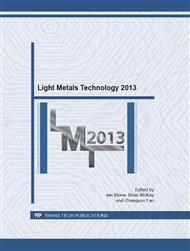p.343
p.348
p.353
p.358
p.363
p.368
p.373
p.378
p.383
Influence of Groove Pressing Process on the Drawability (R Value) of Aluminium Alloy AA 5052 Sheets
Abstract:
Aluminium alloy sheets have poor drawability compared to steel sheets as indicated by the values of the plastic strain ratio or the R value. Because of the textures developed during commercial annealing and cold rolling processes, the R value for aluminium alloys is typically less than 1. Since the R value is heavily influenced by the crystallographic texture in the sheet, processes that develop a favourable texture can be utilised to improve the R value. In this study, a severe plastic deformation process called groove pressing has been used to repeatedly deform sheet specimens of aluminium alloy AA 5052. The R values of groove pressed specimens were experimentally determined. X-ray diffraction scans of the groove pressed specimens were carried out to measure the relative intensities of (111) and (002) peaks in the pattern. The largest increase in the R value was for specimens cut at 90° to the rolling direction and groove pressed to four passes. XRD data indicate that the groove pressing process is capable of introducing a favourable shear texture.
Info:
Periodical:
Pages:
363-367
Citation:
Online since:
July 2013
Authors:
Keywords:
Price:
Сopyright:
© 2013 Trans Tech Publications Ltd. All Rights Reserved
Share:
Citation:


